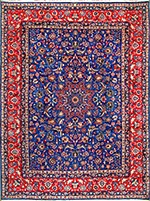Textiles Studies

Textile Research Works
Date of this Version
2001
Document Type
Article
Citation
Exhibition, The Textile Museum, January 26 - April 29, 2001
Abstract
Yemen at the advent of Islam and in the ensuing centuries is a little known entity in our contemporary world. A thousand years ago when Baghdad was capital of the Islamic empire under the Abbasid caliphs, Yemen was a flourishing center of agriculture and trade. By camel caravan north to central Islamic lands and in maritime trade with India to the east and Africa across the straits, Yemen's ports of call along the Red Sea and Gulf of Aden were emporia for textiles, dyestuffs, and incense.
While today Yemen predominantly imports textiles from abroad, in the early centuries after the Islamic conquests Yemeni striped textiles were sought far and wide. As the Abbasid caliphate declined and multiple claims to power gained hold in the provinces, regional artistic styles emerged. The rulers of Yemen adopted one of the prerogatives of the Abbasid caliph, bestowing honor by rewarding subjects with elaborately inscribed textiles called tiraz.
Woven in plain weave—the simplest interlacing of warp and weft—the Yemeni textiles' striped patterns are effected by a resist process, known as ikat, in which sections of the warp yams are selectively dyed before weaving. The inscriptions are applied in gold leaf outlined in black ink, or embroidered using white cotton thread. The dating and attribution is based upon inscribed historical data and calligraphic styles, which find parallels in contemporary coinage.
The Textile Museum's collection of 9th- and 10th-century Yemeni tiraz is one of the most important in the world. George Hewitt Myers, founder of the Museum, acquired these textiles between 1928 and 1952. They bespeak of a cloth that was imbued with great significance as a vehicle for communicating pious benedictions, and which represents the collaboration of calligraphers, dyers, weavers, and embroiderers.
Included in
Art and Materials Conservation Commons, Art Practice Commons, Fiber, Textile, and Weaving Arts Commons, Indigenous Studies Commons, Museum Studies Commons

